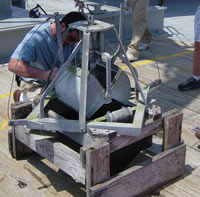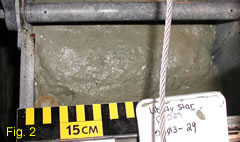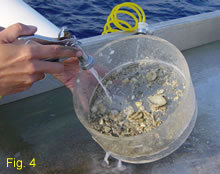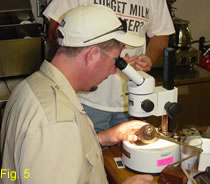|
 |
 |
 |
 |
|
Daily
At-Sea Logs May 3rd, 2003 |
| May 3, 03 It's not Dirt!
Along with the ROV investigations
of the seafloor habitat, we are also quite engaged with sampling of
the seafloor sediments. We are using an instrument called a Smith-MacIntyre
sediment grab sampler (on loan by the SC-Dept. of Natural Resources)
to take as many as 40 small scoops of the ocean's floor (Fig.
1) in and around the Oculina Reef. This instrument is large
and bulky, and is deployed using a Once on
deck, the analysis begins with a photograph of the sediment After this initial collection, the remaining sample is removed from the Smith-Mac. Shipboard geoscientists then describe the appearance of the sediment in terms of its color, homogeneity (i.e., is it all the same or does it have a range of components?) and consistency. We make note of relative amounts of the different "size-fractions," such as the clay + silt size fraction (more commonly known as "mud"), the sand-sized grains, and the coarse material. These sediment characteristics, along with other important site information such as the water depth, latitude/longitude, date and time of day are carefully recorded with a sample identification code in a notebook. The sediments
will also be used for other studies related to the benthic (i.e.,
bottom-dwelling) organisms. Sub-samples of the sediments are soaked
in a solution of ethanol and Rose Bengal that stains and preserves
the living protoplasm a bright magenta color. This method makes identification
of the living populations of "critters" much easier. These
stained samples will be studied by Dr. Murray Roberts of the Scottish
Association for Marine Science to understand the benthic community
of organisms associated with the different seafloor habitats associated
with the Oculina Reef. Some of the reef areas have abundant dead Oculina
"rubble," while other areas are rubble-free and are mostly
composed of sands and broken "shell hash." A few pieces
of Oculina rubble have been recovered so far. One piece was teaming
with a wide variety of tiny invertebrates attached to the coral branches,
as well as a couple of brittle stars (Fig. 3)! Dr. Leslie Sautter, one of the shipboard scientists, will be studying the living populations of benthic foraminifera. Foraminifera are tiny (usually less than 0.5 mm) single-celled organisms in the Kingdom Protista. They produce an enormous array of chambered shells, or "tests," and there are thousands of species living today. Leslie will be assessing the communities of these organisms throughout the reef to determine which groups and species are indicators of certain habitat types. When all
the samples are recorded and stored in labeled containers, the next
Smith-Mac sample is on-deck and ready for attention! Teamwork is very
important to accomplish the sampling rocedure in an efficient manner.
Once in a while there's a little time to explore the sediment's composition
by washing it through a screen, or sieve, to reveal the abundance
of shells and After the
day's sampling is complete, there may be some time to
|
 crane.
Before sending it overboard, the two scoop-like "jaws" are
set in the open position. The Smith-Mac is then lowered to the bottom
and is allowed to "free fall" the last several meters, so
that it hits the seafloor hard enough to release the device that holds
open the jaws. In sandy sediments, the jaws can collect a sizeable
amount of material - perhaps as much as 2-4 liters.
crane.
Before sending it overboard, the two scoop-like "jaws" are
set in the open position. The Smith-Mac is then lowered to the bottom
and is allowed to "free fall" the last several meters, so
that it hits the seafloor hard enough to release the device that holds
open the jaws. In sandy sediments, the jaws can collect a sizeable
amount of material - perhaps as much as 2-4 liters. while
it is still in the sampler
while
it is still in the sampler 
 small
organisms living within (Fig. 4). In
other words, it's fun to play in the mud and sand (it's not dirt!*)
once in a while!
small
organisms living within (Fig. 4). In
other words, it's fun to play in the mud and sand (it's not dirt!*)
once in a while! examine
the material in the lab, under a microscope (Fig.
5). This is when the excitement begins, as we see the microscopic
habitat and its components. There is great beauty in some of the small
shells and mineral grains - beauty that is certainly difficult to
appreciate when viewing it with the naked eye! Images of the fossils,
living organisms and mineral grains will soon be available on the
oceanica web site! We hope to learn a lot about the abundance and
diversity of organisms living within these seafloor habitats, so that
we can establish a "baseline" of what occurs today, for
comparison in the future. These organisms will serve as some of the
many indicators of environmental change over the years, as the Oculina
Coral Banks are studied and monitored.
examine
the material in the lab, under a microscope (Fig.
5). This is when the excitement begins, as we see the microscopic
habitat and its components. There is great beauty in some of the small
shells and mineral grains - beauty that is certainly difficult to
appreciate when viewing it with the naked eye! Images of the fossils,
living organisms and mineral grains will soon be available on the
oceanica web site! We hope to learn a lot about the abundance and
diversity of organisms living within these seafloor habitats, so that
we can establish a "baseline" of what occurs today, for
comparison in the future. These organisms will serve as some of the
many indicators of environmental change over the years, as the Oculina
Coral Banks are studied and monitored.